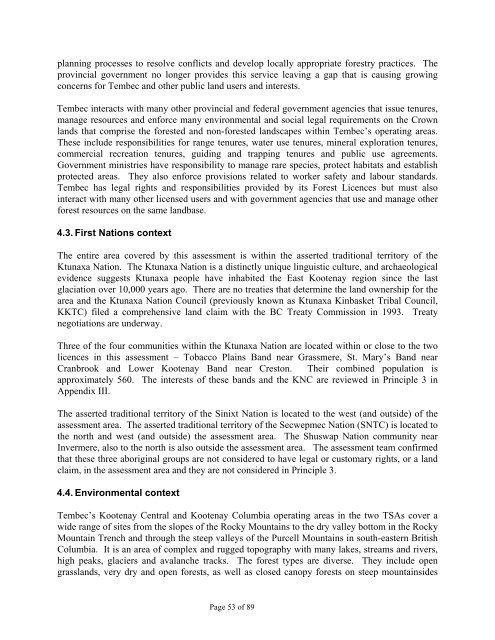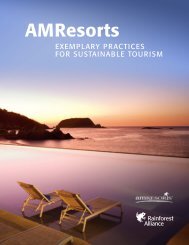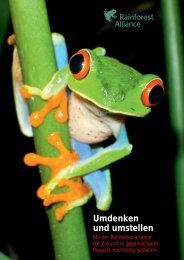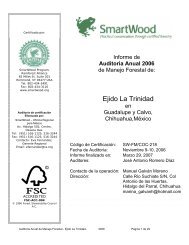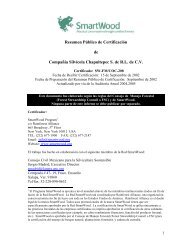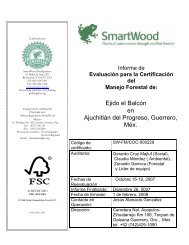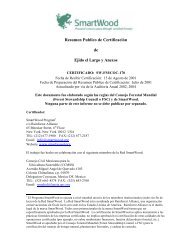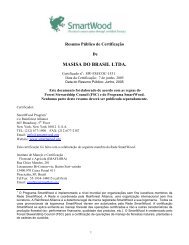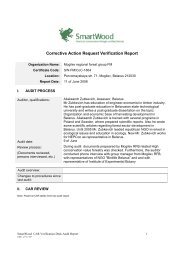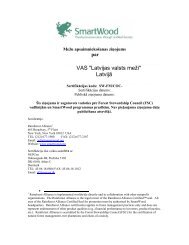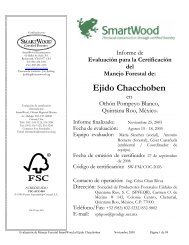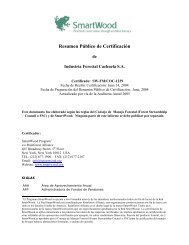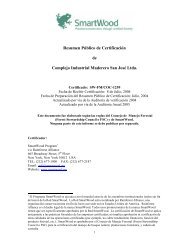Forest Management Certification Assessment Report for - Rainforest ...
Forest Management Certification Assessment Report for - Rainforest ...
Forest Management Certification Assessment Report for - Rainforest ...
Create successful ePaper yourself
Turn your PDF publications into a flip-book with our unique Google optimized e-Paper software.
planning processes to resolve conflicts and develop locally appropriate <strong>for</strong>estry practices. Theprovincial government no longer provides this service leaving a gap that is causing growingconcerns <strong>for</strong> Tembec and other public land users and interests.Tembec interacts with many other provincial and federal government agencies that issue tenures,manage resources and en<strong>for</strong>ce many environmental and social legal requirements on the Crownlands that comprise the <strong>for</strong>ested and non-<strong>for</strong>ested landscapes within Tembec’s operating areas.These include responsibilities <strong>for</strong> range tenures, water use tenures, mineral exploration tenures,commercial recreation tenures, guiding and trapping tenures and public use agreements.Government ministries have responsibility to manage rare species, protect habitats and establishprotected areas. They also en<strong>for</strong>ce provisions related to worker safety and labour standards.Tembec has legal rights and responsibilities provided by its <strong>Forest</strong> Licences but must alsointeract with many other licensed users and with government agencies that use and manage other<strong>for</strong>est resources on the same landbase.4.3. First Nations contextThe entire area covered by this assessment is within the asserted traditional territory of theKtunaxa Nation. The Ktunaxa Nation is a distinctly unique linguistic culture, and archaeologicalevidence suggests Ktunaxa people have inhabited the East Kootenay region since the lastglaciation over 10,000 years ago. There are no treaties that determine the land ownership <strong>for</strong> thearea and the Ktunaxa Nation Council (previously known as Ktunaxa Kinbasket Tribal Council,KKTC) filed a comprehensive land claim with the BC Treaty Commission in 1993. Treatynegotiations are underway.Three of the four communities within the Ktunaxa Nation are located within or close to the twolicences in this assessment – Tobacco Plains Band near Grassmere, St. Mary’s Band nearCranbrook and Lower Kootenay Band near Creston. Their combined population isapproximately 560. The interests of these bands and the KNC are reviewed in Principle 3 inAppendix III.The asserted traditional territory of the Sinixt Nation is located to the west (and outside) of theassessment area. The asserted traditional territory of the Secwepmec Nation (SNTC) is located tothe north and west (and outside) the assessment area. The Shuswap Nation community nearInvermere, also to the north is also outside the assessment area. The assessment team confirmedthat these three aboriginal groups are not considered to have legal or customary rights, or a landclaim, in the assessment area and they are not considered in Principle 3.4.4. Environmental contextTembec’s Kootenay Central and Kootenay Columbia operating areas in the two TSAs cover awide range of sites from the slopes of the Rocky Mountains to the dry valley bottom in the RockyMountain Trench and through the steep valleys of the Purcell Mountains in south-eastern BritishColumbia. It is an area of complex and rugged topography with many lakes, streams and rivers,high peaks, glaciers and avalanche tracks. The <strong>for</strong>est types are diverse. They include opengrasslands, very dry and open <strong>for</strong>ests, as well as closed canopy <strong>for</strong>ests on steep mountainsidesPage 53 of 89


